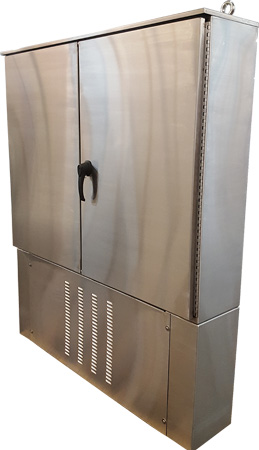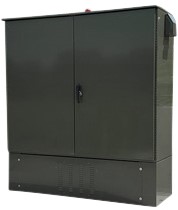< Return to FAQ
What is Required of Electrical Enclosure Manufacturers?

Electrical enclosures are a critical piece of infrastructure used across all industries. Their primary purpose is encasing and protecting electrical components for their optimal performance and the safety of the general public. Adherence to set standards is critical for the mitigation of fire hazards, electric shock, and other threats. West Tool Enclosures provides the best electrical enclosures on the market. With a vast catalog of sizes and configurations to choose from. Get Started here!
Manufacturers Need to Adhere to Enclosure Standards
The design of your electrical enclosure can enhance or inhibit the performance of your circuit board and other components. For that reason, your enclosure manufacturer needs to adhere to industry standards that govern the design and performance of these cabinets.
Industry standards for electrical enclosures include:
- The United States, Underwriters Laboratories (UL)
- The National Electrical Manufacturers Association (NEMA)
NEMA, UL, and IEC Enclosure Standards
NEMA and UL enclosure standards guide cabinet manufacturers, engineers, and installers and the environmental conditions for which they are suitable. Below is a complete list of enclosure standards and requirements for electronic enclosure manufacturers.
| NEMA & UL Rating |
Requirements |
| Type 1 |
These electrical enclosures are for indoor use. They should have features for protecting persons against accidental contact with live parts and prevent the entry of foreign objects into the cabinets. |
| Type 2 |
Both NEMA and UL stipulate that Type 2 standard enclosures should be for indoor use. They should fulfill not only the requirements of Type 1 boxes but also include protection against light dripping and splashing water/non-corrosive liquids. |
| Type 3 |
Under this category, the enclosures should be herculean enough for outdoor use. They should protect personnel from the risk of shock and shield the electrical parts from the ingress of falling and windblown dirt, rain, snow, sleet, and the dangers of the external formation of ice. |
| Type 3R |
For both NEMA and UL, these should be indoor and outdoor enclosures with features that protect personnel against shock and safeguard the equipment from falling dirt, rain, snow sleet, and ice. |
| Type 3RS |
3RS is exclusively a NEMA category for indoor and outdoor enclosures. They should meet all the requirements of Type 3R electrical cabinets, plus additional features for keeping them operable in deep ice conditions. |
| Type 3RX |
Type 3RX is exclusively a NEMA category. These should be outdoor enclosures that satisfy all the requirements of Type 3S with added protection against corrosion. |
| Type 4 |
Both NEMA and UL stipulate that Type 4 enclosures should protect personnel against live parts and shield components from falling and air blown dirt, the ingress of water (including rainwater, splashing water, and hose-directed water), and snow, ice, and sleet. |
| Type 4X |
The enclosures need to have appropriate features for safeguarding against windblown dust, rain, splashing water, hose-directed water, ice, and corrosion. |
| Type 5 |
Type 5 enclosures should feature adequate protection against shock for the personnel, and the ingress of dirt, dust, and flying things and dripping and light splashing water. |
| Type 6 |
Products in this category should protect against contact with hazardous parts and the ingress of dirt. The cabinets should also protect the parts against the entry of hose-directed water and temporary submersion at shallow depths. |
| Type 6P |
These are indoor enclosures that meet all the requirements of type 6 cabinets but with extra protection against hose-directed water, prolonged submersion, and corrosion. The standards are similar for both NEMA and UL. |
| Type 12 |
These enclosures could have knockouts and offer adequate protection against shock and the ingress of dust, dirt, dripping, and splashing water. |
| Type 13 |
The enclosures should meet all the requirements of standard 12 cabinets with added protection against spraying, splashing and seeping water, oil, and non-corrosive liquids. The conditions apply for both NEMA and UL. |
Manufacturers Need to Provide Certification as Proof of Adherence to Standards
When buying electrical enclosures for your various residential, commercial, or industrial applications, you cannot just take a manufacturer’s word as-is regarding quality and standards. NEMA doesn’t test products or inspect their quality.
The best manufacturers should have their enclosures tested by a reputable third-party laboratory (to be sure, there is a list of testing laboratories recommended by NEMA) and get a certificate. That’s the assurance needed to guide you in your buying process. Where there has been proper testing and certification, the enclosures often perform as expected.
Most US companies choose to make the UL certification their primary requirement from electrical enclosure manufacturers when buying electrical enclosures. On its part, UL undertakes the testing of electrical boxes for electronic enclosure manufacturers that seek their certification. Things are more straightforward in this case, eliminating the risk of third-party bias.
For proof of compliance with IEC standards, the electronic enclosure manufacturers shall have to furnish you with an IECEx certification. The latter is a recognition framework based on IEC enclosure IEC 60079 standards for safety and performance in potentially hazardous areas. These areas are referred to as EX areas by the IEC.

Provide Truthful Advertising
Trust is the most valuable asset that electrical enclosure manufacturers can sell to you. In the field, that translates to the reliability, durability, and top performance for the products. The best electronic enclosure manufacturers offer transparency and should be ready to verify the accuracy of their marketing claims.
The performance and design of the enclosures on the ground should be as described in their brochures. The products should:
- Have consistent and reliable strength for safety and performance
- Have sealing and other features for ingress protection
- Have insulation and safety features for protecting personnel against hazardous parts
- Have materials that should be aesthetic and corrosion-resistant (and have fire and UV protection depending on your application)
- Have the right ventilation and thermal protection to increase the life of your electrical equipment
- Be easy to install
Provide Configurable Solutions
Electronic enclosure manufacturers are required to provide the right enclosures that are compatible with your equipment and applications. The design and features of the cabinets should facilitate an effortless installation of your electrical parts, including switchboards and wiring. A highly versatile enclosure can save you high costs down the line, as you can easily customize it for your new applications.
Configurable enclosures should:
- Have all the accessories you want and none of the ones you don’t
- Have custom-cut holes for cabling, air ducts, and buttons among others
- Be configured by you on our design tool
At West Tool Enclosures, we provide highly versatile NEMA and UL-certified enclosures. Our steel enclosures excel in durability and protection against weather and fire hazards. These boxes will get to you ready for wiring and in the shortest turnaround time. We also give you a chance to participate in the design process, and we will keep you in the loop at all times until your order is delivered.
Experience the WTE difference today! Contact us to learn more.